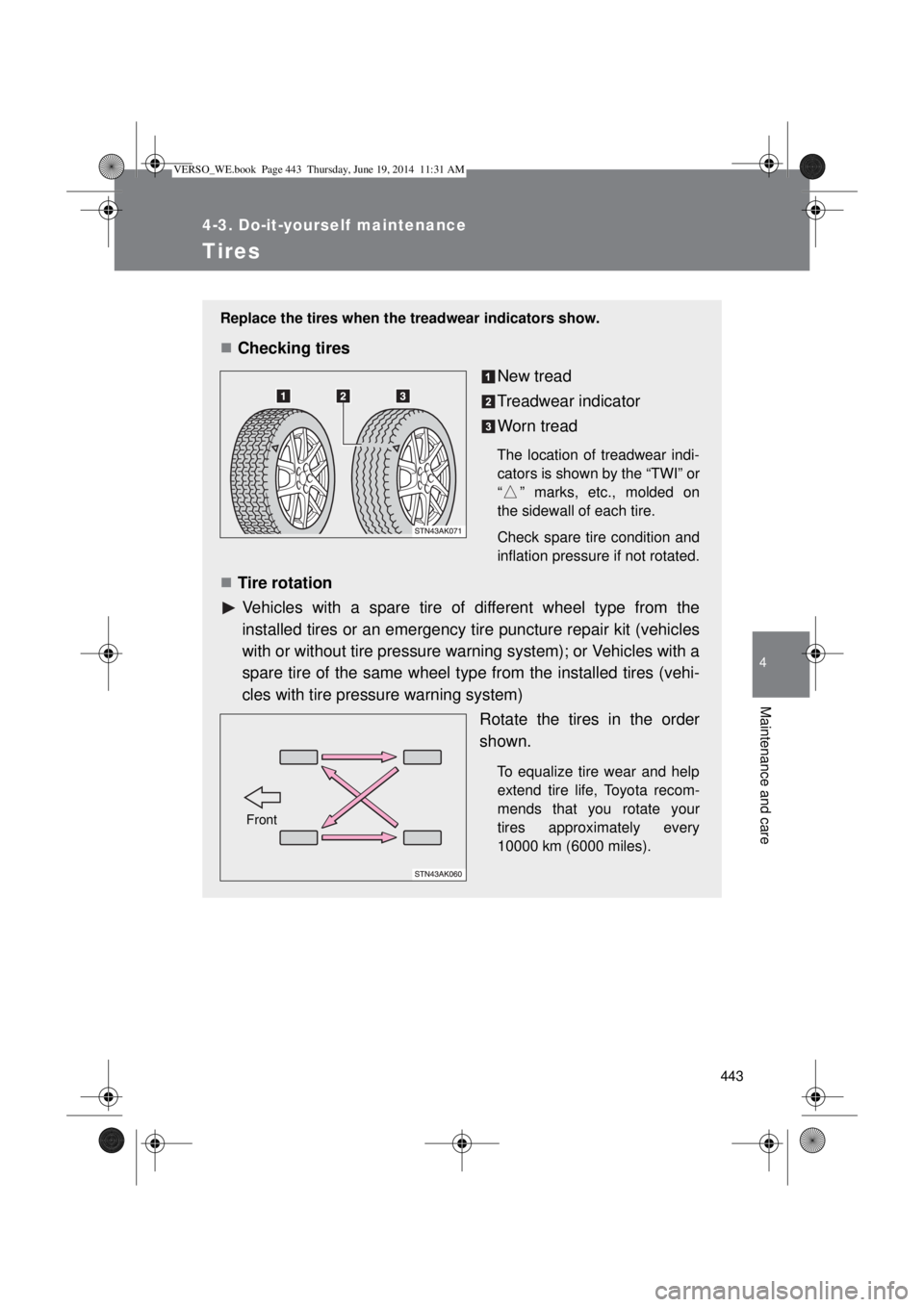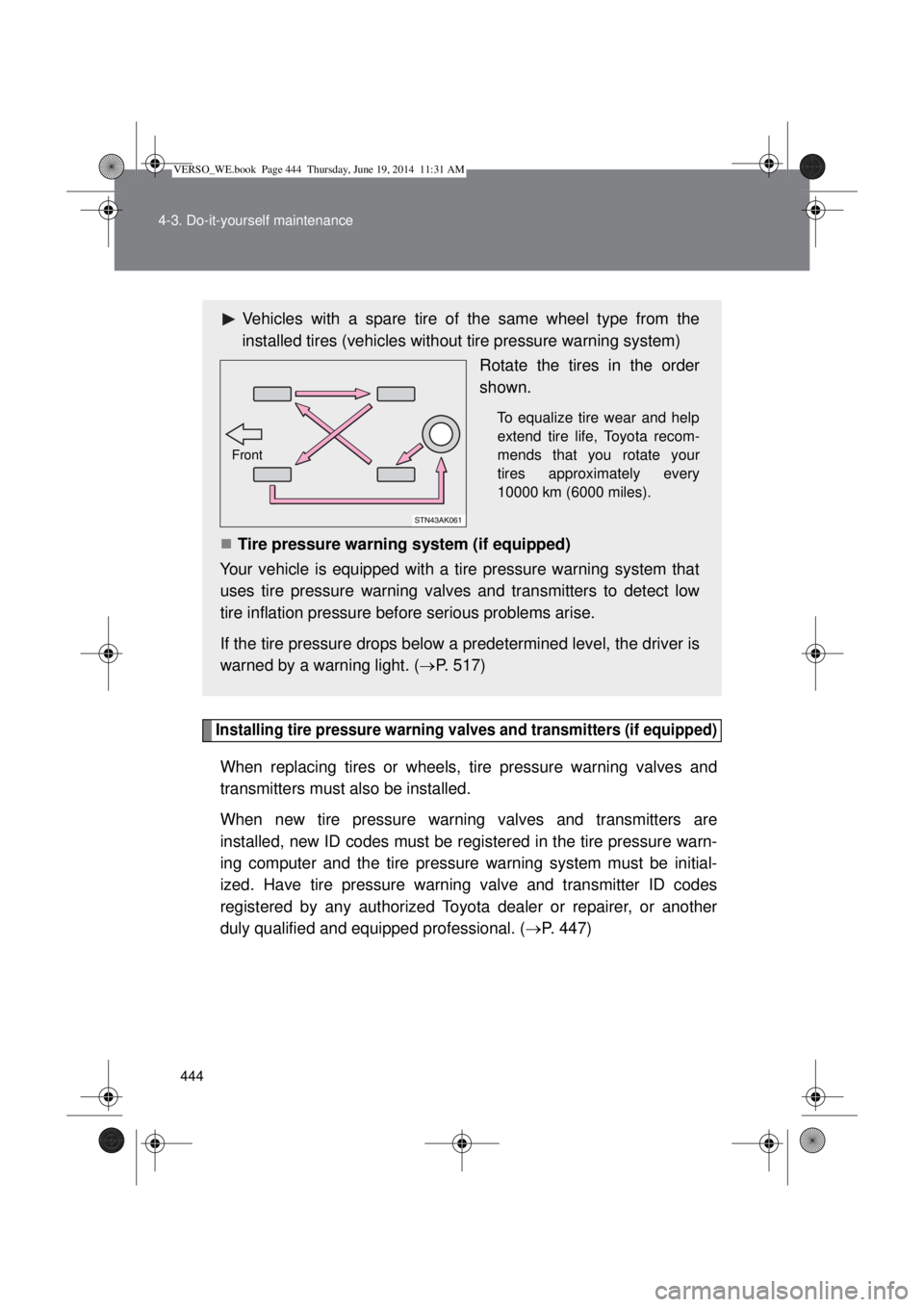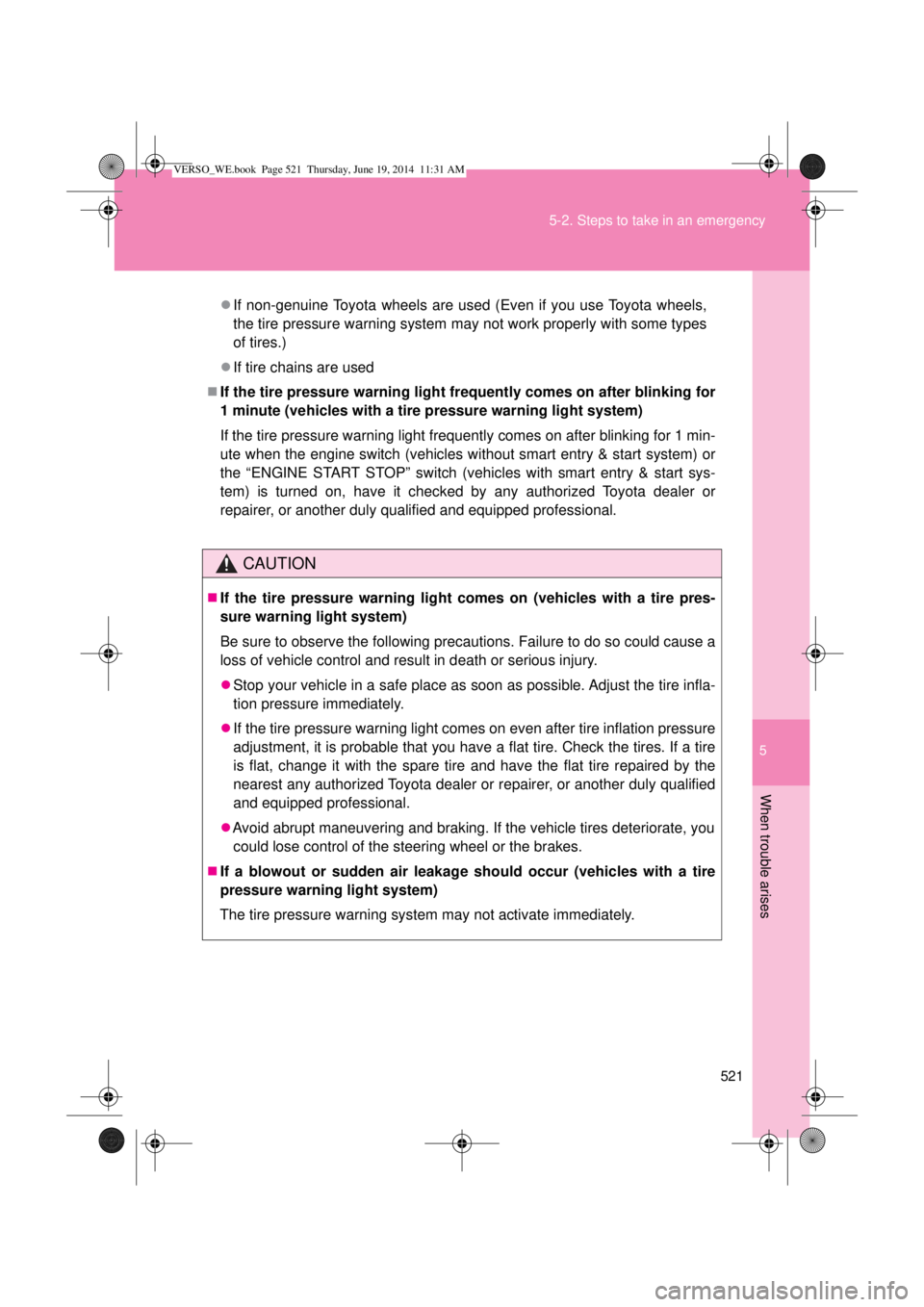2014 TOYOTA VERSO spare tire
[x] Cancel search: spare tirePage 4 of 650

TABLE OF CONTENTSIndex
4
Sun visors ........................... 378
Vanity mirrors...................... 379
Conversation mirror ............ 380
Power outlets ...................... 381
Seat heaters...................... 383
Armrests............................ 385
Front seatback tables........ 386
Rear side sunshades........ 388
Assist grips ......................... 389
Floor mat............................. 390
Luggage compartment features .
392
4-1. Maintenance and care
Cleaning and protecting the ve-
hicle exterior ..................... 402
Cleaning and protecting the ve-
hicle interior ...................... 406
4-2. Maintenance
Maintenance requirements . 409
4-3. Do-it-yourself maintenance
Do-it-yourself service precau-
tions .................................. 412
Hood ................................... 416
Positioning a floor jack ........ 418
Engine compartment........... 420
Tires .................................... 443
Tire inflation pressure ......... 457
Wheels ................................ 459
Air conditioning filter ........... 462
Key battery.......................... 465Checking and replacing fuses ...
469
Light bulbs .......................... 484
5-1. Essential information
Emergency flashers ........... 502
If your vehicle needs to be towed
503
If you think something is wrong .
512
Fuel pump shut off system (gas-
oline engine)..................... 513
5-2. Steps to take in an emergency
If a warning light turns on or a
warning buzzer sounds... . 514
If a warning message is dis-
played............................... 523
If you have a flat tire (vehicles
with spare tire).................. 536
If you have a flat tire (vehicles
with emergency tire puncture
repair kit) .......................... 552
If the engine will not start ... 576
If the shift lever cannot be shifted
from “P” (vehicles with a Multid-
rive or an automatic transmis-
sion) ................................. 579
If you lose your keys .......... 580
If you cannot operate the back
door opener ...................... 581
If the electronic key does not op-
erate properly (vehicles with
smart entry & start system) .....
582
4Maintenance and care
5When trouble arises
VERSO_WE.book Page 4 Thursday, June 19, 2014 11:31 AM
Page 310 of 650

310 2-5. Driving information
When parking the vehicle
Always place wheel chocks under the wheels of both the vehicle
and trailer. Firmly set the parking brake and shift the shift lever to
“P” for Multidrive or automatic transmission, and “1” or “R” for man-
ual transmission.
CAUTION
Follow all the instructions described in this section.
Failure to do so could cause an accident resulting in death or serious injury.
Trailer towing precautions
When towing, make sure that none of the weight limits are exceeded.
(P. 303)
Before descending hills or long declines
Reduce speed and downshift. However, never downshift suddenly while
descending steep or long downhill grades.
Operation of the brake
Do not hold the brake pedal depressed often or for long periods.
Doing so may result in the brake overheating or reduce braking effects.
To avoid accident or injury
Do not exceed 100 km/h (62 mph) or the posted towing speed limit, which-
ever is lower.
Do not use cruise control when you are towing.
Vehicles with a compact spare tire: Do not tow a trailer when the compact
spare tire is installed on your vehicle.
Vehicles with an emergency tire puncture repair kit: Do not tow a trailer
when the tire installed is repaired with the emergency tire puncture repair
kit.
VERSO_WE.book Page 310 Thursday, June 19, 2014 11:31 AM
Page 443 of 650

443
4-3. Do-it-yourself maintenance
4
Maintenance and care
Tires
Replace the tires when the treadwear indicators show.
Checking tires
New tread
Treadwear indicator
Worn tread
The location of treadwear indi-
cators is shown by the “TWI” or
“ ” marks, etc., molded on
the sidewall of each tire.
Check spare tire condition and
inflation pressure if not rotated.
Tire rotation
Vehicles with a spare tire of different wheel type from the
installed tires or an emergency tire puncture repair kit (vehicles
with or without tire pressure warning system); or Vehicles with a
spare tire of the same wheel type from the installed tires (vehi-
cles with tire pressure warning system)
Rotate the tires in the order
shown.
To equalize tire wear and help
extend tire life, Toyota recom-
mends that you rotate your
tires approximately every
10000 km (6000 miles).
Front
VERSO_WE.book Page 443 Thursday, June 19, 2014 11:31 AM
Page 444 of 650

444 4-3. Do-it-yourself maintenance
Installing tire pressure warning valves and transmitters (if equipped)
When replacing tires or wheels, tire pressure warning valves and
transmitters must also be installed.
When new tire pressure warning valves and transmitters are
installed, new ID codes must be registered in the tire pressure warn-
ing computer and the tire pressure warning system must be initial-
ized. Have tire pressure warning valve and transmitter ID codes
registered by any authorized Toyota dealer or repairer, or another
duly qualified and equipped professional. (P. 447)
Vehicles with a spare tire of the same wheel type from the
installed tires (vehicles without tire pressure warning system)
Rotate the tires in the order
shown.
To equalize tire wear and help
extend tire life, Toyota recom-
mends that you rotate your
tires approximately every
10000 km (6000 miles).
Tire pressure warning system (if equipped)
Your vehicle is equipped with a tire pressure warning system that
uses tire pressure warning valves and transmitters to detect low
tire inflation pressure before serious problems arise.
If the tire pressure drops below a predetermined level, the driver is
warned by a warning light. (P. 517)
Front
VERSO_WE.book Page 444 Thursday, June 19, 2014 11:31 AM
Page 460 of 650

460 4-3. Do-it-yourself maintenance
When removing the wheel ornament (vehicles with the wheel cap clip)
When replacing wheels (vehicles with the tire pressure warning sys-
tem)
The wheels of your vehicle are equipped with tire pressure warning valves
and transmitters (except for spare tire) that allow the tire pressure warning
system to provide advance warning in the event of a loss in tire inflation
pressure. Whenever wheels are replaced, tire pressure warning valves and
transmitters must be installed.
(P. 444)
CAUTION
When replacing wheels
Observe the following precautions to reduce the risk of death or serious
injury.
Do not use wheels that are a different size from those recommended in the
Owner’s Manual, as this may result in loss of handling control.
Never use an inner tube in a leaking wheel which is designed for a tube-
less tire.
When installing the wheel nuts
Remove the wheel ornament using the
wheel cap clip.
Be sure to install the wheel nuts with
the tapered ends facing inward. Install-
ing the nuts with the tapered ends fac-
ing outward can cause the wheel to
break and eventually cause the wheel
to come off while driving, which could
lead to an accident resulting in death or
serious injury.Tapered
portion
VERSO_WE.book Page 460 Thursday, June 19, 2014 11:31 AM
Page 501 of 650

5When trouble arises
501
5-1. Essential information
Emergency flashers .......... 502
If your vehicle needs to
be towed ......................... 503
If you think something is
wrong .............................. 512
Fuel pump shut off system
(gasoline engine) ............ 513
5-2. Steps to take in
an emergency
If a warning light turns on
or a warning buzzer
sounds... ........................ 514
If a warning message is
displayed ........................ 523
If you have a flat tire
(vehicles with spare
tire) ................................. 536
If you have a flat tire
(vehicles with emergency
tire puncture repair kit).... 552
If the engine will not
start................................. 576
If the shift lever cannot be
shifted from “P” (vehicles
with a Multidrive or
an automatic
transmission) .................. 579
If you lose your keys ......... 580
If you cannot operate
the back door opener...... 581
If the electronic key does
not operate properly
(vehicles with smart
entry & start system)....... 582If the vehicle battery is
discharged ...................... 585
If your vehicle overheats ... 589
If you run out of fuel and
the engine stalls
(diesel engine) ................ 592
If the vehicle becomes
stuck ............................... 593
If your vehicle has to
be stopped in
an emergency ................. 595
VERSO_WE.book Page 501 Thursday, June 19, 2014 11:31 AM
Page 520 of 650

520 5-2. Steps to take in an emergency
The tire pressure warning light may come on due to natural causes
(vehicles with a tire pressure warning light system)
The tire pressure warning light may come on due to natural causes such as
natural air leaks and tire inflation pressure changes caused by temperature.
In this case, adjusting the tire inflation pressure will turn off the warning light
(after a few minutes).
When a tire is replaced with a spare tire (vehicles with a tire pressure
warning light system)
The spare tire is not equipped with a tire pressure warning valve and trans-
mitter. If a tire goes flat, the tire pressure warning light will not turn off even
though the flat tire has been replaced with the spare tire. Replace the spare
tire with the repaired tire and adjust the tire inflation pressure. The tire pres-
sure warning light will go off after a few minutes.
If the tire pressure warning system is not functioning (vehicles with a
tire pressure warning light system)
The tire pressure warning system will be disabled in the following conditions:
(When the condition becomes normal, the system will work properly.)
If tires not equipped with tire pressure warning valves and transmitters
are used
If the ID code on the tire pressure warning valves and transmitters is not
registered in the tire pressure warning computer
If the tire inflation pressure is 380 kPa (3.9 kgf/cm
2 or bar, 55 psi) or
higher
The tire pressure warning system may be disabled in the following condi-
tions:
(When the condition becomes normal, the system will work properly.)
If electronic devices or facilities using similar radio wave frequencies are
nearby
If a radio set at a similar frequency is in use in the vehicle
If a window tint that affects the radio wave signals is installed
If there is a lot of snow or ice on the vehicle, particularly around the
wheels or wheel housings
VERSO_WE.book Page 520 Thursday, June 19, 2014 11:31 AM
Page 521 of 650

5
521 5-2. Steps to take in an emergency
When trouble arises
If non-genuine Toyota wheels are used (Even if you use Toyota wheels,
the tire pressure warning system may not work properly with some types
of tires.)
If tire chains are used
If the tire pressure warning light frequently comes on after blinking for
1 minute (vehicles with a tire pressure warning light system)
If the tire pressure warning light frequently comes on after blinking for 1 min-
ute when the engine switch (vehicles without smart entry & start system) or
the “ENGINE START STOP” switch (vehicles with smart entry & start sys-
tem) is turned on, have it checked by any authorized Toyota dealer or
repairer, or another duly qualified and equipped professional.
CAUTION
If the tire pressure warning light comes on (vehicles with a tire pres-
sure warning light system)
Be sure to observe the following precautions. Failure to do so could cause a
loss of vehicle control and result in death or serious injury.
Stop your vehicle in a safe place as soon as possible. Adjust the tire infla-
tion pressure immediately.
If the tire pressure warning light comes on even after tire inflation pressure
adjustment, it is probable that you have a flat tire. Check the tires. If a tire
is flat, change it with the spare tire and have the flat tire repaired by the
nearest any authorized Toyota dealer or repairer, or another duly qualified
and equipped professional.
Avoid abrupt maneuvering and braking. If the vehicle tires deteriorate, you
could lose control of the steering wheel or the brakes.
If a blowout or sudden air leakage should occur (vehicles with a tire
pressure warning light system)
The tire pressure warning system may not activate immediately.
VERSO_WE.book Page 521 Thursday, June 19, 2014 11:31 AM